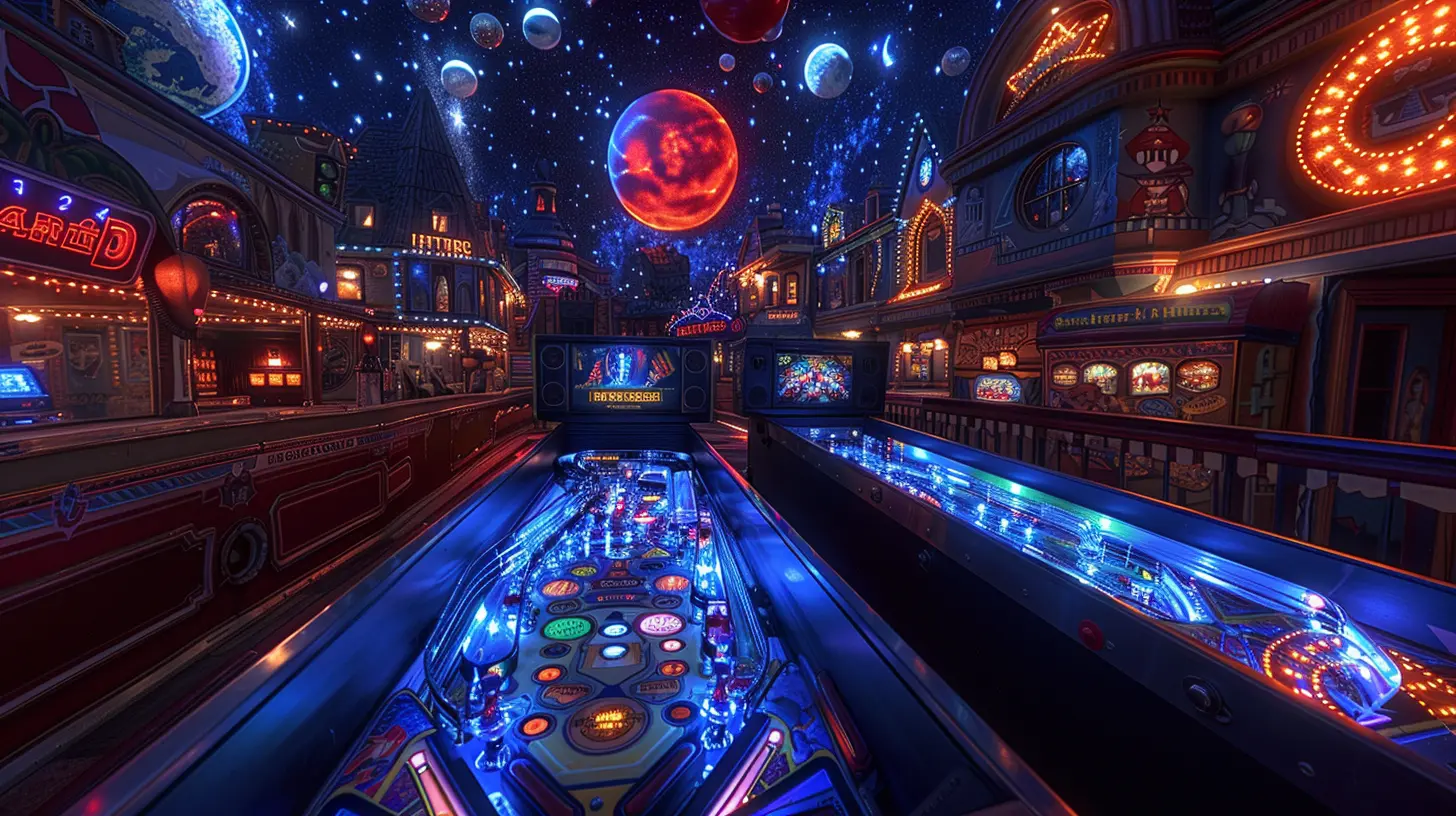A Deep Dive into the Physics of Pinball: The Original Arcade Game
12 September 2025
Pinball — it's loud, flashy, fast, and oddly satisfying. But underneath all those flashing lights and metallic clinks lies something surprisingly deep… physics. Yep, science is hiding in every bounce, ricochet, and spin. So if you’ve ever wondered why that shiny silver ball seems to have a mind of its own, or how even a single nudge changes everything — you’re in the right place.
Grab your flippers (and maybe a soda), because we’re rolling into a deep dive into the physics of pinball — the OG king of the arcade jungle.
What Is Pinball, Really?
Before we go all science-nerd on you (in a fun way, promise), let’s rewind. Pinball is more than just a game — it’s an experience. Born in the early 20th century and booming in the '70s and '80s, pinball machines captured the hearts of gamers long before consoles invaded our living rooms.At its core, pinball is a battle between player reflexes and the chaotic laws of physics. You launch a steel ball onto a slanted playfield, then use flippers to keep it from falling through the bottom. Sounds simple, right? Ah… if only.
The game is built around unpredictability. That’s part of its magic. But all that "randomness" is ruled by one thing: physics.
The Heart of Pinball: Newton’s Laws in Action 🔬
Remember Sir Isaac Newton? The apple guy? Yeah, he’s kind of a big deal in the pinball world — whether he knows it or not.1. Newton’s First Law: The Ball Wants to Chill
Once the ball is in motion, it wants to stay in motion. That’s inertia. But gravity, friction, and bumpers are all working against it, constantly changing its path.Without flippers or obstacles, that ball would roll in a straight line forever. But let’s be realistic — a pinball playfield is more like a battleground than a smooth road.
2. Newton’s Second Law: The Ball’s Got Force
The equation F = ma (force = mass × acceleration) plays a huge role here. When you hit the ball with a flipper, you're applying force. The harder and faster the flip, the more the ball accelerates. Miss the timing, and well... goodbye, multiball.3. Newton’s Third Law: Every Action Has a Reaction
Ever notice how the ball bounces back after hitting a bumper? That’s Newton’s third law showing off. The ball hits with a force, and the bumper pushes right back with equal strength, sending it flying who knows where.
The Geometry of the Playfield 🎯
If physics is the language of pinball, then angles are the grammar.Angles Are Everything
The playfield isn’t flat — it's tilted, usually around 6.5 degrees. Why? So gravity constantly pulls the ball downward. That keeps the game moving and adds urgency. You can't just hang around at the top of the table forever.Plus, every bumper, ramp, and post is intentionally placed at an angle to influence how the ball moves. You might think it's chaos, but there's a method to the madness.
Predicting Trajectories (Sort Of)
Some veteran players get so good, they can pretty much "read" the ball’s future. They know that hitting the ball at a certain angle will send it straight into a ramp or loop.Sounds impressive, but it’s all physics. When the ball strikes a surface, its outgoing angle depends on the incoming angle and the shape of the obstacle. That’s called the Law of Reflection.
But throw in some spin (aka "English") or a weird bounce, and it's a whole new ball game — literally.
Gravity: The Unseen Opponent 🪂
Gravity might be invisible, but it's always working behind the scenes to mess up your perfect score.Why Gravity Matters
From the moment you launch the ball, gravity starts pulling it down the sloped playfield and toward the dreaded drain at the bottom. Your job? Fight gravity with flippers, nudges, and a bit of luck.Ever tried to cradle the ball with a flipper to set up a shot? That’s working against gravity. It's a delicate dance, and gravity never takes a break.
Speed and Momentum
The longer the ball stays in play, the faster it gets — and the harder it becomes to control. That’s momentum stacking up. Gravity accelerates the ball as it moves down the slope, turning it into a speeding bullet you somehow have to tame.The Flippers: Your One True Ally 👊
Flippers are like the knight in shining armor for your poor silver ball.Timing Is Everything
Hit too early, and you’ll pop the ball straight up — not helpful. Hit too late, and it might slip right past. Perfect timing means hitting the ball at just the right angle to send it exactly where you want it.You’re not just mashing buttons — you’re applying leveraged force with physics precision.
The Sweet Spot & Shot Power
Every flipper has a sweet spot — the place where a ball gets the most power and cleanest trajectory. Hitting it delivers killer combos. Miss it, and you're at the mercy of gravity.Collision Physics: Bumpers, Slingshots & Chaos
Let’s talk action and reaction.Elastic Collisions Galore
Most of the hits you see in pinball are elastic collisions. That means energy is conserved, and the ball bounces off with speed and direction changes. Think of it like a hyperactive rubber ball in a small room.Bumpers, posts, and walls all play into this. Each hit changes the ball's kinetic energy and sends it off in unpredictable ways.
Random, But Not Really
The beauty of pinball is that it feels random, but it’s all math under the hood. Every bounce follows the laws of motion, collision physics, and angle deflection.It’s chaos theory at work — tiny changes lead to very different outcomes. A one-degree difference in angle? Could be the difference between jackpot and game over.
The Role of Friction and Spin 🌀
Friction is the sneaky little variable that messes with your game.Slowing Things Down
As the ball rolls across the playfield, it loses energy to friction. That's why it doesn't just keep flying forever — thank goodness. The rubber bumpers, plastic ramps, and even the flippers add different amounts of friction.Spin: Pinball's Secret Sauce
Depending on how the ball hits a surface, it can start spinning. That spin — kinda like curveballs in baseball — can totally change where the ball goes next.It’s tricky, unpredictable, and super fun to watch (unless it sends your ball straight into the drain).
The Art of the Nudge 📟
Ever give the machine a quick bump when the ball’s heading toward doom? Congratulations — you’ve entered the physics of influence.Controlled Chaos
Nudging adds a whole layer of control. You're not hitting the ball directly — you're shifting the entire table just enough to change the ball’s trajectory.Do it too hard, though? You’ll trigger the tilt sensor, and boom — game over. It's like adding cheat codes made of gravity and timing.
Bonus Round: Why Pinball Still Rocks Today 💯
Let’s be real — pinball might be vintage, but it's far from outdated. In fact, it’s making a serious comeback.From classic machines to brand-new releases with digital screens and advanced scoring, pinball is still one of the most physically engaging games out there.
Tactile and Timeless
While video games have gone digital, pinball is still 100% real. You feel every bounce and knock. That physical interaction? It’s addictive. And physics makes it unpredictable — no two games are ever the same.A Playground for Physics Nerds (and That's a Good Thing)
Whether you’re a physics buff or just love flashing lights and high scores, understanding the science behind pinball just makes you appreciate it more. It's like peeling back the curtain to see how the magic works — and realizing it's even cooler than you thought.Final Thoughts: Pinball Is Physics in Motion
So, yeah — that loud, chaotic machine at the corner of your favorite arcade? It’s a playground of physics. It’s Newton, gravity, momentum, and chaos theory all crammed into a glass box with blinking lights and rock music.And knowing the science behind it? That just makes every game more exciting.
Next time you launch that silver ball into orbit, remember — you're not just playing a game. You're interacting with centuries of physics knowledge, one flipper at a time.
So get out there, aim with purpose, nudge (carefully), and embrace the beauty of pinball — physics and all.
all images in this post were generated using AI tools
Category:
Arcade GamesAuthor:

Francesca West
Discussion
rate this article
1 comments
Kyle Thornton
Great article! Pinball's physics truly showcase the blend of art and science—it's fascinating how it captivates us!
September 13, 2025 at 3:51 AM

Francesca West
Thank you! I'm glad you enjoyed the article and appreciate the unique interplay of art and science in pinball!


